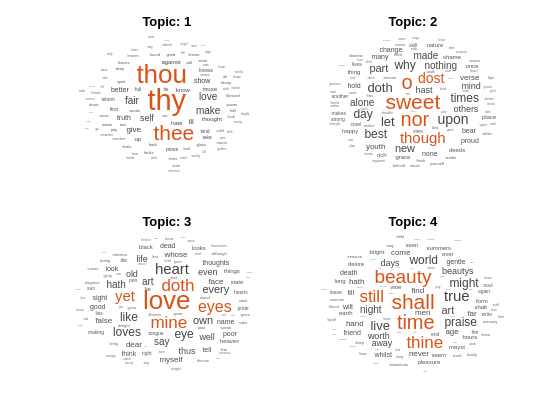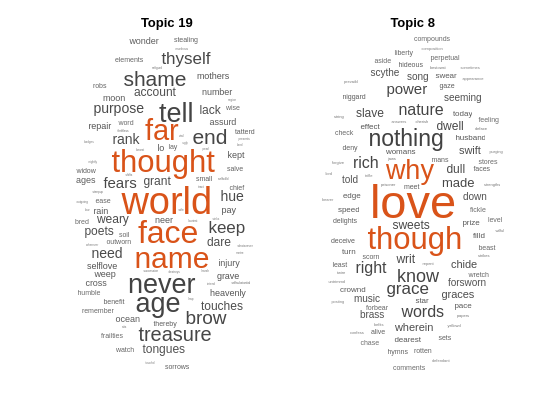ldaModel
LDA 모델
설명
LDA(잠재 디리클레 할당) 모델은 문서 모음에서 기저 토픽을 발견하고 토픽 내 단어 확률을 추정하는 토픽 모델입니다. 이 모델이 bag-of-n-grams 모델을 사용하여 피팅된 경우 소프트웨어는 n-gram을 개별 단어로 처리합니다.
생성
fitlda 함수를 사용하여 LDA 모델을 만듭니다.
속성
LDA 모델 내 토픽 개수로, 양의 정수로 지정됩니다.
토픽 집중도로, 양의 스칼라로 지정됩니다. 이 함수는 토픽당 집중도를 TopicConcentration/NumTopics로 설정합니다. 자세한 내용은 LDA(잠재 디리클레 할당) 항목을 참조하십시오.
단어 집중도로, 음이 아닌 스칼라로 지정됩니다. 소프트웨어는 단어당 집중도를 WordConcentration/numWords로 설정하며, 여기서 numWords는 입력 문서의 단어집 크기입니다. 자세한 내용은 LDA(잠재 디리클레 할당) 항목을 참조하십시오.
입력 문서 집합의 토픽 확률로, 벡터로 지정됩니다. LDA 모델의 말뭉치 토픽 확률은 LDA 모델을 피팅하는 데 사용되는 전체 데이터 세트에서 각 토픽을 관찰할 확률입니다. CorpusTopicProbabilities는 1×K 벡터이며, 여기서 K는 토픽 개수입니다. CorpusTopicProbabilities의 k번째 요소는 토픽 k를 관찰할 확률에 대응됩니다.
입력 문서당 토픽 확률로, 행렬로 지정됩니다. LDA 모델의 문서 토픽 확률은 LDA 모델을 피팅하는 데 사용되는 각 문서에서 각 토픽을 관찰할 확률입니다. DocumentTopicProbabilities는 D×K 행렬로, 여기서 D는 LDA 모델을 피팅하는 데 사용되는 문서 개수이고 K는 토픽 개수입니다. DocumentTopicProbabilities의 (d,k)번째 요소는 문서 d에서 토픽 k를 관찰할 확률에 대응됩니다.
토픽의 확률이 0인 경우(CorpusTopicProbabilities가 0을 포함) DocumentTopicProbabilities와 TopicWordProbabilities에서 대응되는 열은 0입니다.
DocumentTopicProbabilities의 행 순서는 훈련 데이터의 문서 순서에 대응됩니다.
토픽당 단어 확률로, 행렬로 지정됩니다. LDA 모델의 토픽 단어 확률은 LDA 모델의 각 토픽에서 각 단어를 관찰할 확률입니다. TopicWordProbabilities는 V×K 행렬로, 여기서 V는 Vocabulary의 단어 개수이고 K는 토픽 개수입니다. TopicWordProbabilities의 (v,k)번째 요소는 토픽 k에서 단어 v를 관찰할 확률에 대응됩니다.
토픽의 확률이 0인 경우(CorpusTopicProbabilities가 0을 포함) DocumentTopicProbabilities와 TopicWordProbabilities에서 대응되는 열은 0입니다.
TopicWordProbabilities의 행 순서는 Vocabulary의 단어 순서에 대응됩니다.
토픽 순서로, 다음 중 하나로 지정됩니다.
'initial-fit-probability'– 초기 모델 피팅의 말뭉치 토픽 확률을 기준으로 토픽을 정렬합니다. 이 확률은fitlda에서 반환된 초기ldaModel객체의CorpusTopicProbabilities속성입니다.resume함수는 결과로 생성되는ldaModel객체의 토픽을 다시 정렬하지 않습니다.'unordered'– 토픽을 정렬하지 않습니다.
LDA 모델 피팅 시 기록되는 정보로, 다음 필드를 포함하는 구조체로 지정됩니다.
TerminationCode– 종료 시 최적화 상태0 – 반복 한도에 도달했습니다.
1 - 로그 가능도에 대한 허용오차가 충족되었습니다.
TerminationStatus- 반환되는 종료 코드에 대한 설명NumIterations– 수행된 반복 횟수NegativeLogLikelihood–fitlda에 전달된 데이터에 대한 음의 로그 가능도Perplexity–fitlda에 전달된 데이터에 대한 혼잡도(Perplexity)Solver– 사용된 솔버의 이름History– 최적화 내역을 포함하는 구조체StochasticInfo– 확률적 솔버용 정보를 포함하는 구조체
데이터형: struct
모델 내 단어 목록으로, string형 벡터로 지정됩니다.
데이터형: string
객체 함수
logp | Document log-probabilities and goodness of fit of LDA model |
predict | Predict top LDA topics of documents |
resume | Resume fitting LDA model |
topkwords | bag-of-words 모델 또는 LDA 토픽에서 가장 중요한 단어 |
transform | Transform documents into lower-dimensional space |
wordcloud | 텍스트, bag-of-words 모델, bag-of-n-grams 모델 또는 LDA 모델에서 워드 클라우드 차트 만들기 |
예제
이 예제에서 결과를 재현하기 위해 rng를 'default'로 설정합니다.
rng('default')예제 데이터를 불러옵니다. 파일 sonnetsPreprocessed.txt에는 셰익스피어 소네트의 전처리된 버전이 들어 있습니다. 파일에는 한 줄에 하나씩 소네트가 들어 있으며 단어가 공백으로 구분되어 있습니다. sonnetsPreprocessed.txt에서 텍스트를 추출하고, 추출한 텍스트를 새 줄 문자에서 문서로 분할한 후 그 문서를 토큰화합니다.
filename = "sonnetsPreprocessed.txt";
str = extractFileText(filename);
textData = split(str,newline);
documents = tokenizedDocument(textData);bagOfWords를 사용하여 bag-of-words 모델을 만듭니다.
bag = bagOfWords(documents)
bag =
bagOfWords with properties:
Counts: [154×3092 double]
Vocabulary: ["fairest" "creatures" "desire" "increase" "thereby" "beautys" "rose" "might" "never" "die" "riper" "time" "decease" "tender" "heir" "bear" "memory" "thou" "contracted" … ]
NumWords: 3092
NumDocuments: 154
4개 토픽으로 LDA 모델을 피팅합니다.
numTopics = 4; mdl = fitlda(bag,numTopics)
Initial topic assignments sampled in 0.263378 seconds. ===================================================================================== | Iteration | Time per | Relative | Training | Topic | Topic | | | iteration | change in | perplexity | concentration | concentration | | | (seconds) | log(L) | | | iterations | ===================================================================================== | 0 | 0.17 | | 1.215e+03 | 1.000 | 0 | | 1 | 0.02 | 1.0482e-02 | 1.128e+03 | 1.000 | 0 | | 2 | 0.02 | 1.7190e-03 | 1.115e+03 | 1.000 | 0 | | 3 | 0.01 | 4.3796e-04 | 1.118e+03 | 1.000 | 0 | | 4 | 0.01 | 9.4193e-04 | 1.111e+03 | 1.000 | 0 | | 5 | 0.01 | 3.7079e-04 | 1.108e+03 | 1.000 | 0 | | 6 | 0.01 | 9.5777e-05 | 1.107e+03 | 1.000 | 0 | =====================================================================================
mdl =
ldaModel with properties:
NumTopics: 4
WordConcentration: 1
TopicConcentration: 1
CorpusTopicProbabilities: [0.2500 0.2500 0.2500 0.2500]
DocumentTopicProbabilities: [154×4 double]
TopicWordProbabilities: [3092×4 double]
Vocabulary: ["fairest" "creatures" "desire" "increase" "thereby" "beautys" "rose" "might" "never" "die" "riper" "time" "decease" "tender" "heir" "bear" "memory" "thou" … ]
TopicOrder: 'initial-fit-probability'
FitInfo: [1×1 struct]
워드 클라우드를 사용하여 토픽을 시각화합니다.
figure for topicIdx = 1:4 subplot(2,2,topicIdx) wordcloud(mdl,topicIdx); title("Topic: " + topicIdx) end

LDA 토픽에서 확률이 가장 높은 단어의 테이블을 만듭니다.
이 결과를 재현하기 위해 rng를 'default'로 설정합니다.
rng('default')예제 데이터를 불러옵니다. 파일 sonnetsPreprocessed.txt에는 셰익스피어 소네트의 전처리된 버전이 들어 있습니다. 파일에는 한 줄에 하나씩 소네트가 들어 있으며 단어가 공백으로 구분되어 있습니다. sonnetsPreprocessed.txt에서 텍스트를 추출하고, 추출한 텍스트를 새 줄 문자에서 문서로 분할한 후 그 문서를 토큰화합니다.
filename = "sonnetsPreprocessed.txt";
str = extractFileText(filename);
textData = split(str,newline);
documents = tokenizedDocument(textData);bagOfWords를 사용하여 bag-of-words 모델을 만듭니다.
bag = bagOfWords(documents);
20개 토픽으로 LDA 모델을 피팅합니다. 세부 정보가 출력되지 않도록 'Verbose'를 0으로 설정합니다.
numTopics = 20;
mdl = fitlda(bag,numTopics,'Verbose',0);첫 번째 토픽에서 상위 20개 단어를 찾습니다.
k = 20; topicIdx = 1; tbl = topkwords(mdl,k,topicIdx)
tbl=20×2 table
Word Score
________ _________
"eyes" 0.11155
"beauty" 0.05777
"hath" 0.055778
"still" 0.049801
"true" 0.043825
"mine" 0.033865
"find" 0.031873
"black" 0.025897
"look" 0.023905
"tis" 0.023905
"kind" 0.021913
"seen" 0.021913
"found" 0.017929
"sin" 0.015937
"three" 0.013945
"golden" 0.0099608
⋮
첫 번째 토픽에서 상위 20개 단어를 찾고 점수에 역 평균 스케일링을 사용합니다.
tbl = topkwords(mdl,k,topicIdx,'Scaling','inversemean')
tbl=20×2 table
Word Score
________ ________
"eyes" 1.2718
"beauty" 0.59022
"hath" 0.5692
"still" 0.50269
"true" 0.43719
"mine" 0.32764
"find" 0.32544
"black" 0.25931
"tis" 0.23755
"look" 0.22519
"kind" 0.21594
"seen" 0.21594
"found" 0.17326
"sin" 0.15223
"three" 0.13143
"golden" 0.090698
⋮
스케일링된 점수를 크기 데이터로 사용하여 워드 클라우드를 만듭니다.
figure wordcloud(tbl.Word,tbl.Score);

문서에서 LDA 모델을 피팅하는 데 사용된 문서 토픽 확률(토픽 혼합이라고도 함)을 구합니다.
이 결과를 재현하기 위해 rng를 'default'로 설정합니다.
rng('default')예제 데이터를 불러옵니다. 파일 sonnetsPreprocessed.txt에는 셰익스피어 소네트의 전처리된 버전이 들어 있습니다. 파일에는 한 줄에 하나씩 소네트가 들어 있으며 단어가 공백으로 구분되어 있습니다. sonnetsPreprocessed.txt에서 텍스트를 추출하고, 추출한 텍스트를 새 줄 문자에서 문서로 분할한 후 그 문서를 토큰화합니다.
filename = "sonnetsPreprocessed.txt";
str = extractFileText(filename);
textData = split(str,newline);
documents = tokenizedDocument(textData);bagOfWords를 사용하여 bag-of-words 모델을 만듭니다.
bag = bagOfWords(documents);
20개 토픽으로 LDA 모델을 피팅합니다. 세부 정보가 출력되지 않도록 'Verbose'를 0으로 설정합니다.
numTopics = 20;
mdl = fitlda(bag,numTopics,'Verbose',0)mdl =
ldaModel with properties:
NumTopics: 20
WordConcentration: 1
TopicConcentration: 5
CorpusTopicProbabilities: [0.0500 0.0500 0.0500 0.0500 0.0500 0.0500 0.0500 0.0500 0.0500 0.0500 0.0500 0.0500 0.0500 0.0500 0.0500 0.0500 0.0500 0.0500 0.0500 0.0500]
DocumentTopicProbabilities: [154×20 double]
TopicWordProbabilities: [3092×20 double]
Vocabulary: ["fairest" "creatures" "desire" "increase" "thereby" "beautys" "rose" "might" "never" "die" "riper" "time" "decease" "tender" "heir" "bear" "memory" … ] (1×3092 string)
TopicOrder: 'initial-fit-probability'
FitInfo: [1×1 struct]
훈련 데이터에서 첫 번째 문서의 토픽 확률을 표시합니다.
topicMixtures = mdl.DocumentTopicProbabilities; figure bar(topicMixtures(1,:)) title("Document 1 Topic Probabilities") xlabel("Topic Index") ylabel("Probability")

이 예제에서 결과를 재현하기 위해 rng를 'default'로 설정합니다.
rng('default')예제 데이터를 불러옵니다. 파일 sonnetsPreprocessed.txt에는 셰익스피어 소네트의 전처리된 버전이 들어 있습니다. 파일에는 한 줄에 하나씩 소네트가 들어 있으며 단어가 공백으로 구분되어 있습니다. sonnetsPreprocessed.txt에서 텍스트를 추출하고, 추출한 텍스트를 새 줄 문자에서 문서로 분할한 후 그 문서를 토큰화합니다.
filename = "sonnetsPreprocessed.txt";
str = extractFileText(filename);
textData = split(str,newline);
documents = tokenizedDocument(textData);bagOfWords를 사용하여 bag-of-words 모델을 만듭니다.
bag = bagOfWords(documents)
bag =
bagOfWords with properties:
Counts: [154×3092 double]
Vocabulary: ["fairest" "creatures" "desire" "increase" "thereby" "beautys" "rose" "might" "never" "die" "riper" "time" "decease" "tender" "heir" "bear" "memory" "thou" "contracted" … ]
NumWords: 3092
NumDocuments: 154
20개 토픽으로 LDA 모델을 피팅합니다.
numTopics = 20; mdl = fitlda(bag,numTopics)
Initial topic assignments sampled in 0.513255 seconds. ===================================================================================== | Iteration | Time per | Relative | Training | Topic | Topic | | | iteration | change in | perplexity | concentration | concentration | | | (seconds) | log(L) | | | iterations | ===================================================================================== | 0 | 0.04 | | 1.159e+03 | 5.000 | 0 | | 1 | 0.05 | 5.4884e-02 | 8.028e+02 | 5.000 | 0 | | 2 | 0.04 | 4.7400e-03 | 7.778e+02 | 5.000 | 0 | | 3 | 0.04 | 3.4597e-03 | 7.602e+02 | 5.000 | 0 | | 4 | 0.03 | 3.4662e-03 | 7.430e+02 | 5.000 | 0 | | 5 | 0.03 | 2.9259e-03 | 7.288e+02 | 5.000 | 0 | | 6 | 0.03 | 6.4180e-05 | 7.291e+02 | 5.000 | 0 | =====================================================================================
mdl =
ldaModel with properties:
NumTopics: 20
WordConcentration: 1
TopicConcentration: 5
CorpusTopicProbabilities: [0.0500 0.0500 0.0500 0.0500 0.0500 0.0500 0.0500 0.0500 0.0500 0.0500 0.0500 0.0500 0.0500 0.0500 0.0500 0.0500 0.0500 0.0500 0.0500 0.0500]
DocumentTopicProbabilities: [154×20 double]
TopicWordProbabilities: [3092×20 double]
Vocabulary: ["fairest" "creatures" "desire" "increase" "thereby" "beautys" "rose" "might" "never" "die" "riper" "time" "decease" "tender" "heir" "bear" "memory" "thou" … ]
TopicOrder: 'initial-fit-probability'
FitInfo: [1×1 struct]
새 문서로 구성된 배열의 상위 토픽을 예측합니다.
newDocuments = tokenizedDocument([
"what's in a name? a rose by any other name would smell as sweet."
"if music be the food of love, play on."]);
topicIdx = predict(mdl,newDocuments)topicIdx = 2×1
19
8
워드 클라우드를 사용하여 예측된 토픽을 시각화합니다.
figure subplot(1,2,1) wordcloud(mdl,topicIdx(1)); title("Topic " + topicIdx(1)) subplot(1,2,2) wordcloud(mdl,topicIdx(2)); title("Topic " + topicIdx(2))

세부 정보
LDA(잠재 디리클레 할당) 모델은 문서 모음에서 기저 토픽을 발견하고 토픽 내 단어 확률을 추정하는 문서 토픽 모델입니다. LDA는 단어 확률로 구성된 벡터 로 특징지어진 K개의 토픽에 대해 D개의 문서 모음을 토픽 혼합 로 모델링합니다. 이 모델은 토픽 혼합 , 토픽 가 각각 집중도 파라미터 와 를 포함하는 디리클레 분포를 따른다고 가정합니다.
토픽 혼합 는 길이가 K인 확률 벡터이며, 여기서 K는 토픽 개수입니다. 요소 는 토픽 i가 d번째 문서에서 나타날 확률입니다. 토픽 혼합은 ldaModel 객체의 DocumentTopicProbabilities 속성 행에 대응됩니다.
토픽 는 길이가 V인 확률 벡터이며, 여기서 V는 단어집의 단어 개수입니다. 요소 는 단어집의 v번째 단어가 i번째 토픽에 나타날 확률에 대응됩니다. 토픽 는 ldaModel 객체의 TopicWordProbabilities 속성 열에 대응됩니다.
토픽 와 토픽 혼합에 대한 디리클레 사전 확률 가 주어지면, LDA는 문서에 대해 다음과 같은 생성적 프로세스를 가정합니다.
토픽 혼합 를 샘플링합니다. 확률 변수 는 길이가 K인 확률 벡터이며, 여기서 K는 토픽 개수입니다.
문서 내 각 단어에 대해 다음이 적용됩니다.
토픽 인덱스 를 샘플링합니다. 확률 변수 z는 1부터 K까지의 정수이며, 여기서 K는 토픽 개수입니다.
단어 를 샘플링합니다. 확률 변수 w는 1부터 V까지의 정수이며, 여기서 V는 단어집의 단어 개수이고 단어집에서 대응되는 단어를 나타냅니다.
이 생성적 프로세스에서 단어 과 토픽 혼합 , 토픽 인덱스 가 있는 문서의 결합 분포는 다음에 의해 지정됩니다.
여기서 N은 문서의 단어 개수입니다. z에 대한 결합 분포를 합산한 다음 에 대해 적분하면 문서 w의 주변 분포가 다음과 같이 생성됩니다.
다음 도식은 LDA 모델을 확률적 그래픽 모델로 보여줍니다. 음영 처리된 노드는 관찰된 변수이고 음영 처리되지 않은 노드는 잠재 변수이며 윤곽선이 없는 노드는 모델 파라미터입니다. 화살표는 확률 변수 간의 종속성을 강조 표시하고 플레이트는 반복된 노드를 나타냅니다.

디리클레 분포는 다항 분포의 연속적인 일반화입니다. 범주 수 및 집중도 파라미터 (여기서 은 길이가 K인 양의 실수로 구성된 벡터)가 주어진 경우, 디리클레 분포의 확률 밀도 함수는 다음에 의해 지정됩니다.
여기서 B는 다음에 의해 지정되는 다변량 베타 함수를 나타냅니다.
특수한 디리클레 분포 중 하나로 대칭 디리클레 분포가 있습니다. 대칭 디리클레 분포는 집중도 파라미터 로 특징지어지며, 여기서 의 모든 요소는 동일합니다.
버전 내역
R2017b에 개발됨
MATLAB Command
You clicked a link that corresponds to this MATLAB command:
Run the command by entering it in the MATLAB Command Window. Web browsers do not support MATLAB commands.
웹사이트 선택
번역된 콘텐츠를 보고 지역별 이벤트와 혜택을 살펴보려면 웹사이트를 선택하십시오. 현재 계신 지역에 따라 다음 웹사이트를 권장합니다:
또한 다음 목록에서 웹사이트를 선택하실 수도 있습니다.
사이트 성능 최적화 방법
최고의 사이트 성능을 위해 중국 사이트(중국어 또는 영어)를 선택하십시오. 현재 계신 지역에서는 다른 국가의 MathWorks 사이트 방문이 최적화되지 않았습니다.
미주
- América Latina (Español)
- Canada (English)
- United States (English)
유럽
- Belgium (English)
- Denmark (English)
- Deutschland (Deutsch)
- España (Español)
- Finland (English)
- France (Français)
- Ireland (English)
- Italia (Italiano)
- Luxembourg (English)
- Netherlands (English)
- Norway (English)
- Österreich (Deutsch)
- Portugal (English)
- Sweden (English)
- Switzerland
- United Kingdom (English)